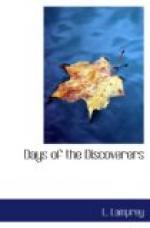“You bide here with me awhile, lad. Maybe there’s a way for you to get learning, yet.”
Will shared the leafy booth and simple fare of his new friend for a fortnight, doing errands, rubbing down the black horse, Tamlane, and at odd times learning his conjugations. When John Smith left his hermitage and went to fight against the Turks in Transylvania, he placed a little sum of money with a Puritan scholar at Scrooby to pay for the boy’s schooling for a year or two. The yeoman uncle had a family of his own to provide for, and was glad to have Will off his hands.
Transylvania in 1600 was on the very frontier of Christendom. John Smith needed all the philosophy he had learned from his favorite author when, after many adventures, he was taken prisoner and sent to the slave-market of Axopolis to be sold. Bogal, a Turkish pacha, bought the young Englishman to send as a gift to his future wife, Charatza Tragabigzanda, in Constantinople.
Chained by the neck in gangs of twenties the slaves entered the great Moslem city. John Smith was left at the gate of a house exactly like all the others in the narrow noisy street. The beauty of an Oriental palace is inside the walls. Within the blank outer wall of stone and mud-brick, arched roofs, painted and gilded within, were upheld by slender round pillars of fine stone—marble, jasper, porphyry, onyx, red syenite, highly polished and sometimes brought from old palaces and temples in other lands. Intricate carving in marble or in fine hard wood adorned the doorways and lattices, and the balconies with their high lattice-work railings where the women could see into a room below without being seen. In the courtyards fountains plashed in marble basins, and from hidden gardens came the breath of innumerable roses. On floors of fine mosaic were silken many-hued rugs, brought in caravans from Bagdad, Moussoul or Ispahan, and the soft patter of bare feet, morocco shoes and light sandals came from the endless vistas of open arches. A silken rustling and once a gurgle of soft laughter might have told the Englishman that he was watched, but he knew no more what it meant than he understood the Arabic mottoes, interwoven with the decoration of the blue-and-gold walls.
Charatza’s curiosity was aroused at the sight of a slave so tall, ruddy and handsome. She sent for him to come into an inner room where she and her ladies sat, closely veiled, upon a cushioned divan. Bogal’s letter said that the slave was a rich Bohemian nobleman whom he had captured in battle, and whose ransom would buy Charatza splendid jewels. But when spoken to in Bohemian the captive looked perfectly blank. He did not seem to understand one word.
Arabic and Turkish were no more successful. At last the young princess asked a question in Italian and found herself understood. It did not take long for her to find out that the story her lover had written had not a word of truth in it. She was as indignant as a spirited girl would naturally be.




